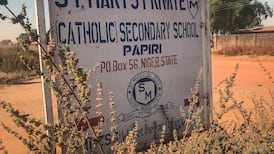It has been just over two years since suspected Islamic extremists planted a bomb at a cafe in Marrakesh’s Djemaa el-Fna square, killing 17 people, including 14 tourists from Europe and Canada.
The site of that attack on April 28th, 2011, the Cafe Argana, is located at the square's northeast corner near the entrance of the Moroccan city's souk, a market that sells everything from colourful rugs and aromatic spices to ornamental weapons and intricately designed jewellery.
Today, the remains of the cafe – tourists always gathered on its second floor to watch the bustling square – are eerily hidden behind a 30m-high construction curtain over its bomb-blasted walls.
It is a constant reminder to Moroccans and foreigners that Islamic extremists view the North African country, one of the few in the region to remain relatively calm during the Arab Spring, as a threat to the radical doctrine they espouse. The government has blamed al-Qaeda for the bombing and four men have been convicted of carrying it out.
Previous attack
Indeed the 2011 attack was not the first time Islamic extremists have targeted the country. In 2003, a group of 12 suicide bombers co-ordinated an attack on the coastal city of Casablanca, killing themselves and 33 other people in one bloody day.
Unlike other Arab countries, Morocco is a constitutional monarchy that has committed itself to a process of political reform under the king, Muhammad VI, who inherited the throne in 1999. There is an elected parliament in which all of its society's ideological threads, including followers of the Islamic faith, are represented and play a role.
Supporters of the system say it seeks to accommodate the different groups – the indigenous Berbers, the Arabic groups, Muslims and Jews – rather than allow the dominant one to rule unchallenged. Indeed, to show solidarity with their fellow country people following the attack in Marrakesh many of the country's Islamists came together to express their support for the king.
While Morocco’s society is far from perfect, with high levels of poverty and inequality between the sexes, its political set-up and spirit of compromise and co-operation appear to have staved off the troubles its neighbouring countries have succumbed to over the past few years.
Economic plight
Moroccans have, like citizens in Egypt, Tunisia and Libya, been hit by the hardships associated with the fallout from global financial crisis and regional upheavals that have dampened growth.
Official government figures put unemployment at 9.1 per cent, but they don’t take into account seasonal workers or people working in the informal economy. Experts say the real rate of joblessness is much higher.
Unemployment among the youth, who were at the forefront of change across the region, is also very high at 30 per cent. Many Moroccans say the changes and reforms are being introduced too slowly, but it seems the majority still want their grievances dealt with in the political system as opposed to following the path of their neighbours.
While haggling with a shop owner near Cafe Argana over the price of a hookah pipe and a lamp, I asked him what he remembered from the day the bomb went off, and whether Islamic extremism was now a major concern for ordinary Moroccans.
He shook his head when thinking back to the awful scenes, but he maintained that although some Moroccans did support extremism, their numbers were small. This sentiment was echoed by other Moroccans across the country when I asked their views.
Indeed, it seems the terrorists’ successful disruption of one of Morocco’s most famous tourist attractions appears to have been shortlived. A memorial to those who died has been constructed in the middle of the square and, across Djemaa el-Fna, thousands of locals and tourists are once again gathering to watch the street theatre that has taken place each day here since about 1050.
Some watch snake charmers who, for a few dirhams, calm spitting cobras with exotic melodies played on traditional flutes; others look on as young acrobats summersault through the air and perform impressive balancing acts on each other’s shoulders.
Djemaa el-Fna translates from Arabic into English as “Assembly of the Dead”.
In its current incarnation the square is very much a tribute to the living as well as Morocco’s rich cultural heritage.












